The X Button
Interstellar Assault
by Todd Ciolek,
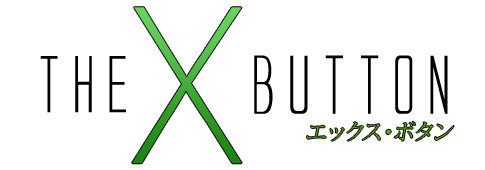
This week deals heavily with Konami's latest shooter, Otomedius. I'm a little unkind to the game, and I suspect this has something to do with Axelay, Konami's 1992 Super NES shooter. You'll see a few references to the game in Otomedius, but they only remind me that Konami never made an Axelay 2. And then I'm disappointed.
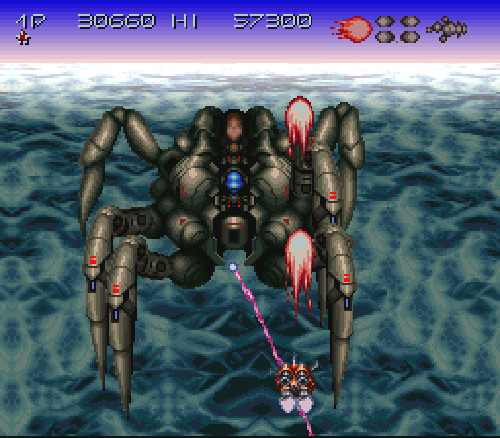
Axelay's easily my favorite of the Konami shooter stable, and that's partly because it ignores a lot of frequently bothersome conventions. Instead of grabbing power-ups in the style of Gradius, players go into stages with three selectable weapons equipped, from wet-sounding fireballs to heat-seeking miniguns, and they lose whatever weapon they're using if they take a hit. It's a nice solution to the problem of shooters that leave you vulnerable and doomed if you're stripped of your power-ups.
Also, the Axelay fighter does a dance at the end of every stage. I like those little touches.
NEWS
FINAL FANTASY XIII-2'S VILLAIN IS…A FINAL FANTASY VILLAIN
Final Fantasy XIII lacked a few things, and one of them was a proper antagonist. Square Enix isn't making that mistake in Final Fantasy XIII-2; instead of a shapeshifting pope who just sorta pops in and acts evil here and there, the villain is a more active swordsman named Caius Ballad. Not only the rival of the original game's heroine Lightning, Caius is also the former friend of Noel, a time-traveling kid who helps Lightning's sister Serah.
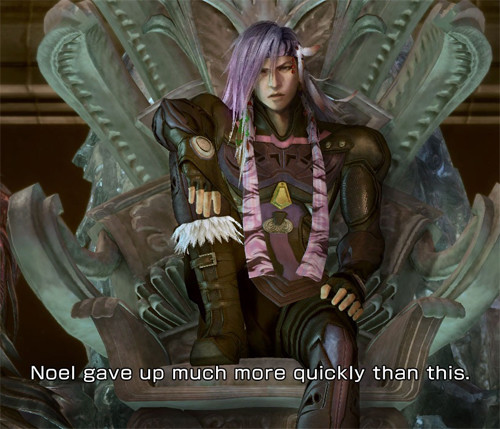
Apparently not driven by conquest or insanity, Caius wants to destroy Noel and Serah because they're mucking around with space and time. Yes, he's TimeCop as designed by Square Enix artist Yusuke Naora. But he's also more in line with what Final Fantasy fans have come to expect in their ne'er-do-wells, and that might win over a few souls who hated Final Fantasy XIII. And that's clearly weighing on Square's collective mind as the game nears its December launch in Japan.
HYPERDIMENSION NEPTUNIA MK2 COMES TO NORTH AMERICA
Last year's Hyperdimension Neptunia had a neat idea: an RPG where all of the characters and settings represent the video-game industry. Some complained about the battle system and others complained about all of the personified consoles and companies being too-cute “moe” women, but a number of people bought the game anyway (to the point where NIS America recently reprinted it). And now NISA has the sequel ready for a U.S. release in February. The PlayStation 3 RPG returns to the world of Gamindustri, where the original game's heroine Neptune and her three system-symbolizing goddess allies are kidnapped. Neptune's younger sister Nepgear (after the Game Gear) sets out to save them, accompanied by the equally younger siblings of Sega and Nintendo game consoles.
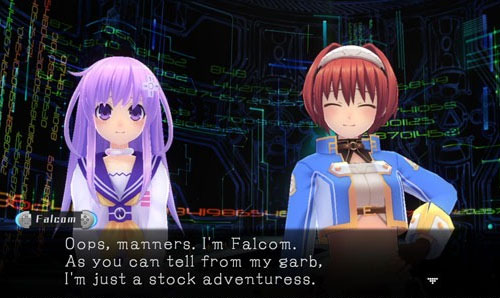
Developer Compile Heart aimed the Neptunia sequel even more acutely at anime obsessives, though they've also broadened the cast to include heroines based on RPG powerhouse Falcom (who's a plucky swordswoman) and shooter factory Cave (who's a bullet-spewing maid). The returning cast members look slightly different as well, since they've changed from slightly animated 2-D cutouts to polygon models. Compile Heart also tried to improve the combat: characters can now move around the battlefield, and the resulting fights progress a little faster than the routine encounters of the original Neptunia.
IN BRIEF: SQUARE ENIX READIES A NEW ACTION GAME, UDON HAS PERSONA ARTBOOKS IN STORE
Square Enix is courting Western audiences more than ever, and their latest game may well be aimed at the Skyrim and Dragon Age crowd. Currently without a title, the game is an action-RPG with a heavy medieval-fantasy element, and the limited scenery shown so far suggests something less in line with Final Fantasy exaggeration. The game also uses the Unreal Engine 3, which brings to mind the first time Square Enix employed the Unreal ending. We ended up with The Last Remnant, a game despised by many and liked by a few. That might not be the key to winning over Western RPG fans, but I'm glad to see Square Enix trying something that's not Final Fantasy or Dragon Quest.
Udon may be best known for Capcom material, as they publish all sorts of artbooks and comics based on Street Fighter, Darkstalkers, and Mega Man. They've branched out into other games, however, and they're now expanding into Shin Megami Tensei territory. Shigenori Soejima Artworks, featuring the work of the frequent Persona/SMT/Atlus-game character designer, arrives at the end of December. Persona 3 Design Works is slated for March, with the Persona 4 version arriving in April. There'll probably be a little overlap between the three books, but I have no doubt that some Persona fans will buy all three.
REVIEW: OTOMEDIUS EXCELLENT
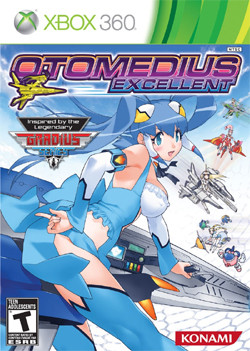 Developer: Konami
Developer: Konami
Publisher: Konami
Platform: Xbox 360
Players: 1-3
MSRP: $29.99/$49.99 (special edition)
Otomedius Excellent is unquestionably a product of the modern anime industry. It can be classified as a spin-off of Konami's enduring Gradius shooter series, but Otomedius exists because of the present-day phenomenon of “moe,” the art of stuffing something with cute-as-can-be anime girls until the whole production explodes in a burst of big eyes and embarrassment. I'd like to say that there's more to Otomedius Excellent, that it's a sturdy shooter beneath all of its calculated character designs. But that's a hard lie to tell.
Much like the original Otomedius, Excellent pays ample tribute to Konami's catalog. There's a backstory about high-school pilots (all girls) taking on “Bacterion” aliens and the ominous threat of Dark Force (also a girl), but Otomedius is largely about two things: serving creepy anime-heroine archetypes and cramming in references to Konami games. The pilots are led by blue-haired Aoba Anon and her fairly standard Gradius-like space fighter, with the rest of the cast and their mounts recalling Xexex, Twinbee, Axelay, Ajax, Castlevania, and even the Japan-only Getsu Fuma Den. Konami never loses sight of the moe factor, though. All of the characters are designed by Sgt. Frog creator Yoshizaki Mine at his least family-friendly, and the game lets players poke large, squealing portraits of the girls.
Once the game is fully launched, however, it's a Gradius affair through and through. A pioneer among strategic shooters, Gradius offered a novel weapon system for its day. Each power-up grabbed activates another section of a ship's arsenal, and players can either spend those power-ups on lower-level abilities or hoard them for better ones. Of course, Gradius games usually force a player's hand with fierce enemy attacks and many sudden ways to lose a fighter—and with it, most of the power-ups acquired.
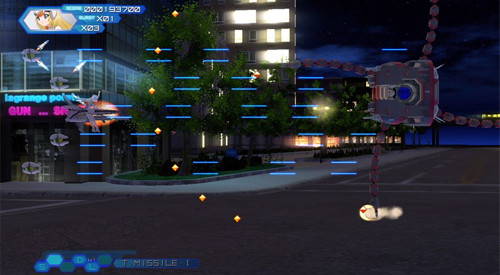
The Gradius formula has many drawbacks, and Otomedius Excellent preserves most of them. Most annoying is the fact that nearly all of the characters are rather sluggish, and they need at least one “speed” power-up to have a fighting chance. Yet Gradius shows no mercy to players who die even once. They're robbed of their arsenals, except for the recoverable “option” drones, and the game's ridiculously hard when you're equipped with only the basic needle-spitter and one speed boost.
There's nothing wrong with a drastically tough shooter, provided that its level design holds up. Most of Excellent's doesn't, I'm afraid. The levels are largely routine flights of repetitive pawn enemies, most of which are pulled from generic Gradius lore. Only the boss encounters are particularly creative, as they bring in popular Konami characters to pilot heavily armed battleships (Ruby and Cobalt from Parodius fit right in, less so Shiori from Konami's smash-hit dating sim Tokimeki Memorial). Even those battles get tedious, particularly when a time-warp brings up a burst of bosses that all use the same basic idea. Yes, the “shoot the core” warship's shielded center is a classic component of the Gradius franchise. No, it doesn't have to show up on nearly every boss.
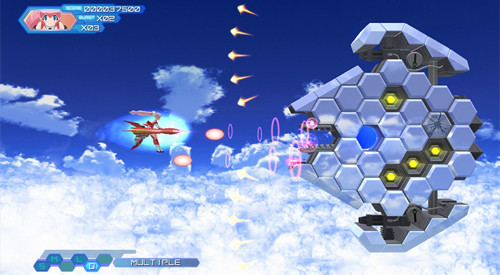
Yet Otomedius Excellent keeps casual shooter players in mind. Bosses will actually give up and go away if they're not defeated in time. In an unfortunate move, the game also offers unlimited on-the-spot continues, and that's perhaps the last thing it needs. Otomedius is the sort of pattern-based shooter that players memorize and navigate bit by bit, and the checkpoint-based continue system of previous Gradius games fit this idea fairly well. Constant continues just cheapen the whole idea. But then Otomedius borrows too little from the best of the franchise. It needed more Gradius V, more Lifeforce, more Gradius Gaiden—and less of the Gradius that was dated and frustrating by 1987.
Otomedius Excellent looks decent in its use of 3-D models in two-dimensional gameplay, though enemy bullets often blend into the more brightly lit backgrounds. The soundtrack's a bubbly mix, and the voices…well, they fit the characters. Konami's subtitling job could be more thorough, but you can rest easy knowing that a catgirl boss's defeated yowl is, in fact, spelled “Reowwwrrr.”
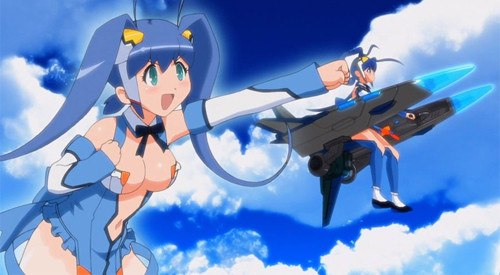
If it's not a particularly good shooter, there's at least plenty of Otomedius Excellent to go around. The game's seven pilots (plus four others to be unlocked or bought as DLC) are diverse in their armaments, with dozens of different weapons to test. The lasers, ripple beams, bombs, missiles, rocket punches, and “valcan” machine guns are available in many different forms, even if a few seem downright useless. There's also a three-player mode, a welcome break from the two-ship confines of many old-school shooters.
Clumsy and banal, Otomedius Excellent never touches the best modern shooters, perhaps because it relies on Gradius a bit too much. Instead of splicing together the good parts of all Konami's shooters, Excellent simply draws upon the dull ideas of an old and not necessarily classic piece of genre history. There's certainly an audience for Otomedius Excellent and its cutesy space pilots, but that audience shouldn't include anyone interested in a remotely decent shooter.
NEXT WEEK'S RELEASES
FORTUNE STREET  Developer: Square Enix
Developer: Square Enix Publisher: Nintendo Platform: Nintendo Wii Players: 1-4 MSRP: $49.99 Let it never be said that Nintendo of America is afraid of testing out an unfamiliar franchise…so long as that franchise has Mario all over it. The Itadaki Street series is one of those old, old warhorses of the Japanese game industry, dating all the way back to the days of the Famicom. A board-game simulation, Itadaki Street titles find characters buying and selling properties while an elaborate stock market hums behind the scenes. Comparisons to Monopoly are well-earned, but the systems of Fortune Street (as it's to be known here) allow for multiple players to buy stock in real estate, so a property's owner isn't the only one who benefits when someone lands on a certain space. And much like actual life, a random stroke of luck can destroy a carefully poised financial empire. The original Itadaki Street was the work of Dragon Quest creator Yuji Hori, so the two series often intertwine. Some previous Itadaki Streets combined Dragon Quest with Final Fantasy, but the latter gives way to Mario for this Wii outing and the franchise's North American debut. The playable characters of Fortune Street include the usual Mario roundup (plus Donkey Kong and Diddy Kong), and the Dragon Quest side samples from throughout the series, including Dragon Quest V's Bianca, Dragon Quest IX's ko-gal fairy Stella, and Dragon Quest VIII's Jessica and Angelo, plus the spin-off's youthful version of Yangus. And a slime, of course. All of the properties similarly correspond to landmarks from Mario games and Dragon Quest, so players will buy ghost houses and castles instead of Boardwalk and Baltic.
|
MARIO KART 7 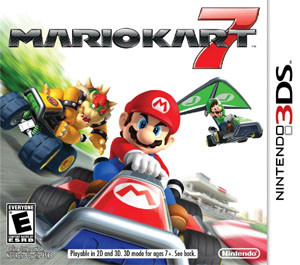 Developer: Nintendo EAD
Developer: Nintendo EAD Publisher: Nintendo Platform: Nintendo 3DS Players: 1-8 MSRP: $39.99 It's a small surprise to see a game called Mario Kart 7, as previous titles went by less blunt names like Mario Kart Double Dash and Mario Kart DS. It might sow chaos to rival the Great Panic of '97, when hordes of RPG fans rioted in the streets, demanding the fourth, fifth, and sixth Final Fantasies that they'd apparently missed. Or perhaps not. Mario Kart 7 is, after all, a happy game where Nintendo characters putter around in go-karts. It's sweet and funny for all of ten seconds. Then someone nails you with a Koopa shell and runs you off the road. Mario Kart 7 has many venues for this disruption, as the courses number well past thirty without even counting the bonus battle arenas. The roster features most of the major drivers from Mario Kart Wii (including Rosalina, who's apparently now part of the Mario A-listers), and the absent ones are replaced with new faces. Honey Bee, Wiggler, and the oft-sidelined Latiku are there, along with the somewhat unnerving Metal Mario. The main draw of Mario Kart 7, however, is the chance to customize karts. They can be modified with everything from spongy tires to hang-glider wings, and the game's tracks play up this new aerial feature. Races also support eight players—though anyone without a physical copy of Mario Kart 7 has to use the Shyguy in a basic kart. But you know what? I like the Shyguy.
|
discuss this in the forum (20 posts) |
this article has been modified since it was originally posted; see change history